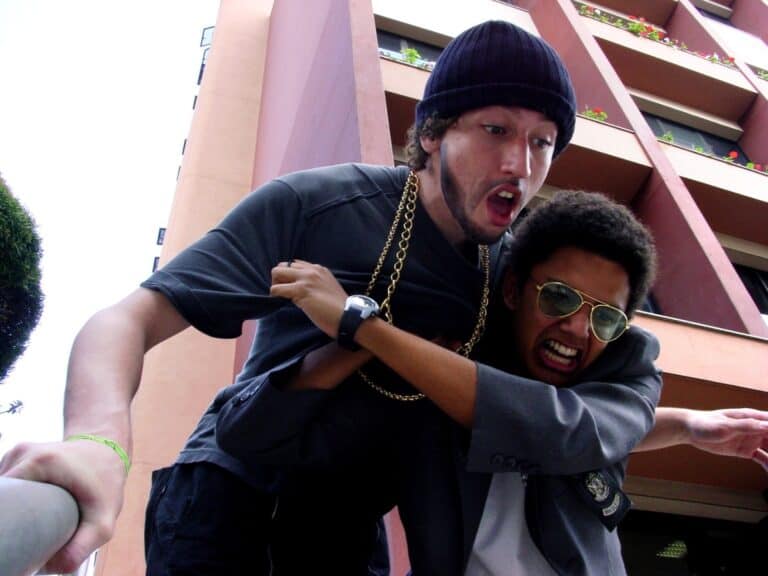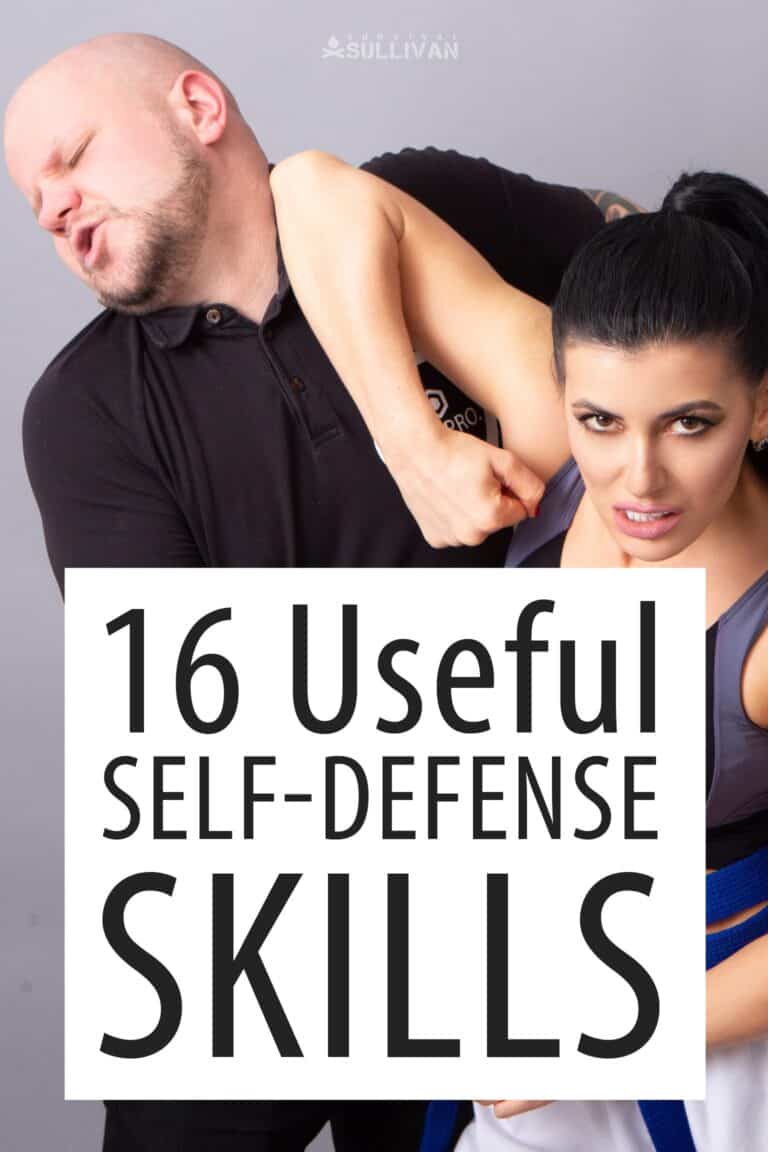Self-defense is a topic that’s just full of misunderstandings and misinterpretations.

In the eight – almost nine – years that I’ve been training in martial arts, every discussion on the topic of self-defense has focused on the physical side of things.
Now, that’s fine to a point but there’s much more to it than punching and kicking.
These situations are scary, and these skills can help you deal with these situations better if and/or when you end up in them.
With that in mind, I thought we’d look at some of the most useful self-defense skills to have.
1. Taking a Hit
There’s no getting around it, getting punched or kicked sucks! It hurts and as humans we prefer to avoid anything uncomfortable/painful.
Even so, you have to be able to handle getting hit if you want to effectively defend against an attack.
The more used to it you are the less likely you are to freeze; you’ll be able to concentrate on fighting back.
You’re also less likely to be disoriented by a hit if you’re used to taking them – keep in mind that your body is much stronger than you think and can take a substantial beating.
2. Quick Response
Being able to react to a situation quickly is crucial if you want to get away with minimal damage to your person.
Having a quick response means it’s possible for you take control of the situation and maintain that advantage.
Self-defense situations can be very dangerous, and a quick response time/reaction means that you can stop a situation from escalating and going completely off the rails.
Whether it’s to physically restrain or stop somebody or talk them down so that they don’t try to knock your lights out, a quick response is definitely something that you need to work on.
3. Situational Awareness
Keeping your head on a constant swivel and being aware of your surroundings can help prevent you being overwhelmed in a self-defense situation.
You can use your environment to your advantage and somewhat avoid serious injuries yourself.
You know where your exits are and can position yourself to get to them easily if needed. There are three levels of situational awareness: perception, understanding, and prediction.
You perceive what’s happening based on what information you have about a situation. You understand what’s happening and predict what might happen – again based on what information you have.
4. Footwork and Head Movement
Using proper footwork and head movement allows you to move around fairly easily and fight without getting your lights punched out.
You learn to be more maneuverable and make things very difficult for a would-be attacker.
Footwork and head movement is something you learn very, very quickly – especially in boxing – because obviously if you get bonked on the head in a boxing match it’s going to be very unpleasant.
5. Keeping your Guard Up
This seems obvious, doesn’t it? If your hands drop while you’re fighting, you’re going to get knocked out.
As simple as it is, many students – me included – struggle to keep their guard up consistently. Ideally, you want to keep your hands in the same place throughout a match.
If they fall, you become vulnerable. Most knockouts happen because your hands fall somewhere along the line and allow your opponent easy access to your face and head.
Bottom line: keep your hands up if you want your lights to stay on!
6. Maintain a Confident Appearance
Okay, so this is kind of like the Jedi mind trick.
Presenting a confident appearance, walking upright with your eyes always moving around, and speaking in an assured manner gives a prospective attacker the idea that you’re not the easy prey for which he’s looking.
Most bad guys are opportunists but they’re not too likely to go for someone who looks like they can handle themselves.
7. Adaptability
This is a straightforward one, being able to fight at all ranges and in any environment is crucial but it’s even more crucial that you can adapt to a situation.
Thinking on the fly and improvising solutions as you go isn’t very easy, but it can give you a significant edge over the other person.
If you know what you’re doing when pinned to the ground, you can fight your way out and take control of the fight; you’re not going to panic wondering what you should do.
8. Communication / De-Escalation Skills
What’s de-escalation? Well, de-escalation is behavior that is aimed at preventing conflicts from going too far.
A major part of de-escalation is being able to communicate clearly both verbally and non-verbally; the clearer your communication skills are, the better.
If you are able to talk to someone and persuade them to walk away from a fight – that’s a win!
Now, how would you use this skillset? If someone is in your face and screaming and swearing at you – maybe they throw a few threats in for good measure – being able to talk them down is crucial to keeping your lights on.
9. Striking, Kicking, and Grappling Skills
This is usually the first thing that comes to mind when it comes to self-defense. The physical side of things.
You must have a good arsenal of skills under your belt to handle the physical side of the confrontation.
A good set of striking and kicking skills makes it possible to fight at long and medium (kicking and striking) ranges.
Grappling skills are also crucial because, if you watch footage of street fights, many times the fight ends up going to the ground. Now, going to the ground is never going to be a good position in a street fight.
You can get kicked and stomped on by other people, it’s harder to keep the fight contained to just you and your opponent, and you could potentially lose a lot of mobility.
With that said, stand-up grappling is a thing, and a good set of grappling skills means you could potentially avoid going to the ground without losing control of the other person.
10. Distance Management
Distance management is exactly what it sounds like, managing the amount of distance between you and your attacker/opponent.
Keeping a safe distance that you can use to effectively defend yourself is vital if you want to keep your teeth in your mouth and your internal supercomputer running.
11. Keeping yourself Fit
Ah, fitness – something that is often ignored in the self-defense world. Many people think they’ll be able to just do something – sort of rise to the occasion deal.
This is simply not the case; self-defense can be a very physical experience and if your opponent is in better physical condition, they’re more than likely to outrun you and/or overpower you.
How do you avoid this? Well, you exercise regularly and keep yourself in the best possible physical condition.
12. Keep a Non-Confrontational Stance
One of the five responses to a confrontation is submission. You keep your hands up and out in front of you – preferably open – and try to talk the other person down.
Saying things like: “I don’t want trouble” or something similar can sometimes be enough to persuade the other person that they’re not going to get their way with you.
Keeping a non-confrontational/submissive stance also helps on the legal side of things.
Cameras are literally everywhere nowadays, and people seem to prefer pulling out their phones to grab a cool video to actually trying to help.
Now, what that does is put your confrontation in front of a crowd and, if the video ends up in court, then the way you’re standing can go a long way towards helping a claim of self-defense.
13. Trust your Instincts
Your instincts are there for a reason. As humans, we generally prefer to avoid conflict where possible and usually, if something doesn’t feel right, we get out of dodge.
If something doesn’t seem right or you don’t like how something looks, just take yourself out of the equation.
Leave the area and, if it turns out to be nothing, so what? At least you’re safe, and if something happened after you left; you didn’t get caught in the crossfire.
It’s better to be safe than sorry
14. Use Surprise
We all like a good surprise now and then, right? Well, in self-defense cases, not so much.
We don’t like people sneaking up on us and grabbing us or hurting us and guess what the bad guys don’t like getting hurt either.
A punch in the face or a kick to the groin is going to be a nasty, painful surprise which can get you a few seconds to get away.
15. Remember the KISS Principle and Keep it Simple
KISS stands for Keep It Simple Stupid, and is exactly what it says: you keep your techniques simple and effective.
Remember that a street fight is nothing like the Dojo, trying something fast and flashy is great in the Dojo where you’re trying to impress a panel of judges at a tournament or grading.
In a street fight, that’s something that can cost you precious seconds and leave you very vulnerable so just keep it simple.
16. Keep Calm
Much like taking a hit, you must be able to keep a clear head and be able to think on your feet. You can’t think properly if you freak out when someone shoves you or knocks you down.
So, keep calm and do what you have to do until the threat isn’t a threat anymore.
Everyone Can Have These Skills
Everyone can have these skills, it’s just a matter of keeping them sharp. Self-defense situations or street fights are no joke, and they often go off the rails very quickly.
People can get seriously injured even if they’re not in the fight directly. The bulk of these skills are built around avoiding a conflict altogether and I hope you find them helpful.
I’ve said it before, and I’ll say it until I’m blue in the face, it’s not worth risking life and limb to prove how tough you are.
Anytime you can walk away from a situation without fighting is a win – even if it’s not a very cinematic or flashy win.
I hope you guys enjoyed this article and found it informative. As always, thanks for reading and I’ll see you in the next one. Until then, take care and stay safe out there!


Greg spent much of his younger years camping and hiking. Greg grew up on a small farm with lots of livestock such as cows, horses and chickens. He’s good with a bow and arrow, is a huge knife enthusiast, and has a blackbelt in Taekwondo.

Great points. Would be interesting if you could elaborate on defense skills for those of us who are elderly. I am 75 and in reasonably good shape. I go to the gym for cardio using the stair stepper and I use exercise machines to keep up muscle strength. However, I have knee replacements and neuropathy so my agility is not great. So, running away from something wouldn’t work.
Many of your points are also valid for old folks, especially situational awareness, but are there any additional ways old folks can protect themselves not mentioned in your article?
I have a conceal carry permit and if I’m not carrying, I usually have some pepper spray close at hand, but I read that pepper spray can enrage someone high on drugs and if that happens, I would not likely prevail so using that would only be under dire circumstance same as using a firearm–not to mention legal issues.
Anyway, I would most appreciate your comments. Thank you. JED